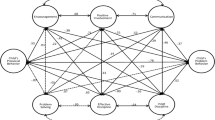Abstract
The purpose of this study was to examine the antecedents of child compliance and noncompliance. Both maternal and child behaviors served as predictors. Fifty-six clinic-referred children and their mothers served as subjects. Data were collected in the home setting by independent observers. Four multiple regression analyses were performed. The results indicated that the behavior immediately preceding child compliance or noncompliance typically was the best predictor. Furthermore, the antecedents for child compliance and noncompliance differed. For maternal antecedents, the type of command that served as the best predictor for child compliance and noncompliance differed; however, the final predictor equation was similar for the two types of child behaviors. For child antecedents, compliance was best predicted by compliance and noncompliance was best predicted by noncompliance. The results are discussed in terms of Patterson's coercion hypothesis.
Similar content being viewed by others
References
Bernhardt, A. J., & Forehand, R. (1975). The effects of labeled and unlabeled praise upon lower and middle class children.Journal of Experimental Child Psychology, 19, 536–543.
Forehand, R. L. (1977). Child compliance to parental requests: Behavioral analysis and treatment. In M. Hersen, R. M. Eisler, & P. M. Miller (Eds.),Progress in behavior modification (Vol. 5, pp. 111–147). New York: Academic Press.
Karpowitz, D. H., & Johnson, S. M. (1981). Stimulus control in child-family interaction.Behavioral Assessment, 3, 161–171.
Lutzker, J. R., McGimsey, J. F., McRae, S., & Campbell, R. V. (1983). Behavioral parent training: There's so much more to do.Behavior Therapist, 6, 110–112.
Martin, J. A., Maccoby, E. E., Baron, K. W., & Jacklin, C. N. (1981). The sequential analysis of mother-child interaction at 18 months: A comparison of micro-analytic methods.Developmental Psychology, 17, 146–157.
Patterson, G. R. (1973). Changes in status of family members as controlling stimuli: A basis for describing treatment process. In L. A. Hamerlynck, L. C. Handy, & E. J. Mash (Eds.),Behavior change: Methodology, concepts, and practice (pp. 169–191). Champaign, Illinois: Research Press.
Patterson, G. R. (1974). A basis for identifying stimuli which control behaviors in natural settings.Child Development, 45, 900–911.
Patterson, G. R. (1976). The aggressive child: Victim and architect of a coercive system. In E. J. Mash, L. A. Hamerlynck, & L. C. Handy (Eds.),Behavior modification and families (pp. 267–316). New York: Brunner/Mazel.
Patterson, G. R. (1977). Accelerating stimuli for two classes of coercive behaviors.Journal of Abnormal Child Psychology, 5, 335–350.
Patterson, G. R. (1979). A performance theory for coercive family interaction. In R. B. Cairns (Ed.),The analysis of social interactions: Methods, issues, and illustrations (pp. 119–162). Hillsdale, New Jersey: Erlbaum.
Patterson, G. R. (1982).Coercive family process: A social learning approach (Vol. 3). Eugene, Oregon: Castalia.
Roberts, M. W., Hatzenbuehler, L. C., & Bean, A. W. (1981). The effects of differential attention and time out on child noncompliance.Behavior Therapy, 12, 93–99.
Roberts, M. W., McMahon, R. J., Forehand, R., & Humphreys, L. (1978). The effect of parental instruction-giving on child compliance.Behavior Therapy, 9, 793–798.
Sanders, M. R., & Dadds, M. R. (1982). The effects of planned activities and child management procedures in parent training: An analysis of setting generality.Behavior Therapy, 13, 452–461.
Thomas, E. A., & Malone, T. W. (1979). On the dynamics of two person interactions.Psychological Review, 86, 331–360.
Thomas, E. A., & Martin, J. A. (1976). Analysis of parent-infant interaction.Psychological Review, 83, 141–156.
Wahler, R. G., & Fox, J. J. (1981). Setting events in applied behavior analysis: Toward a conceptual and methodological expansion.Journal of Applied Behavior Analysis, 14, 327–338.
Author information
Authors and Affiliations
Rights and permissions
About this article
Cite this article
Williams, C.A., Forehand, R. An examination of predictor variables for child compliance and noncompliance. J Abnorm Child Psychol 12, 491–503 (1984). https://doi.org/10.1007/BF00910661
Issue Date:
DOI: https://doi.org/10.1007/BF00910661




